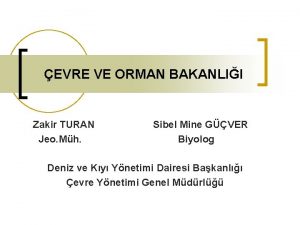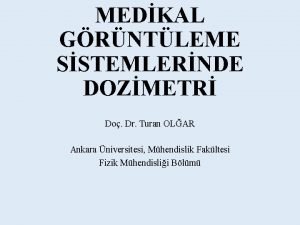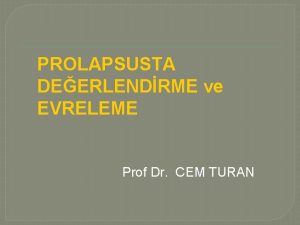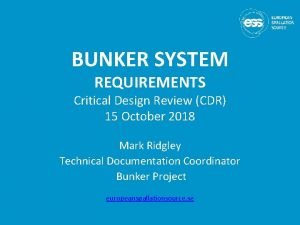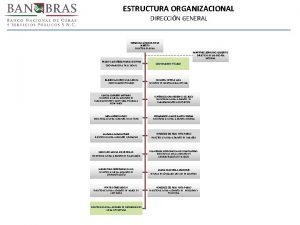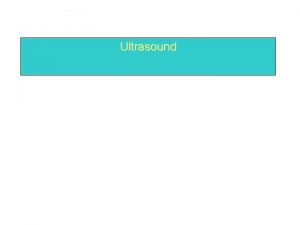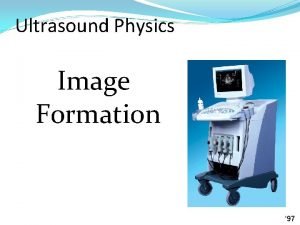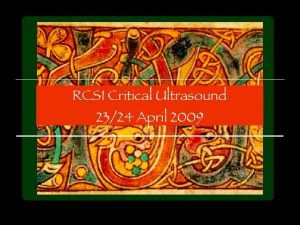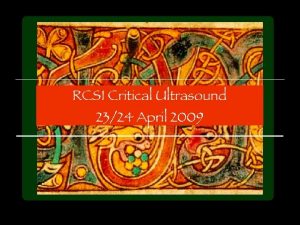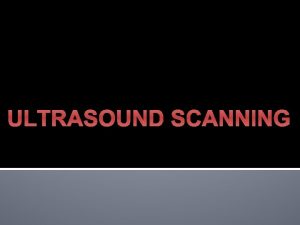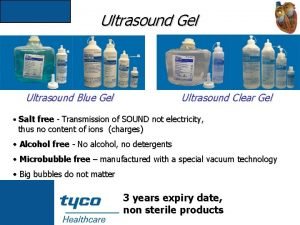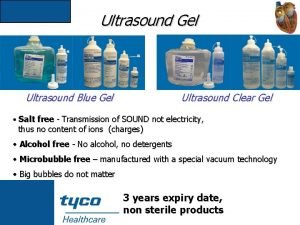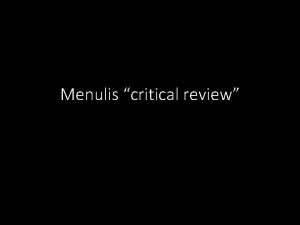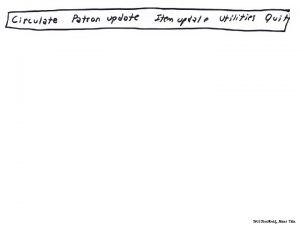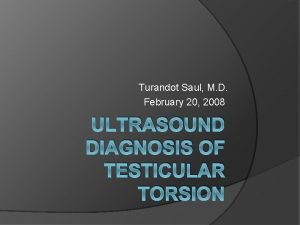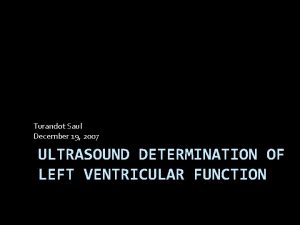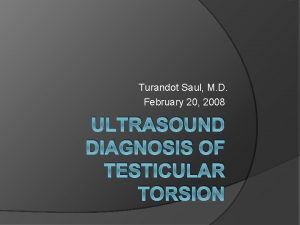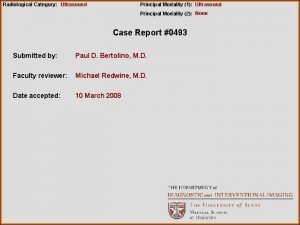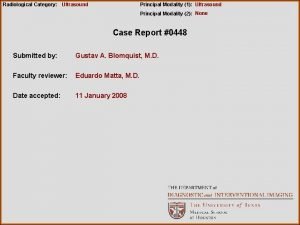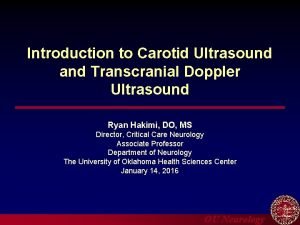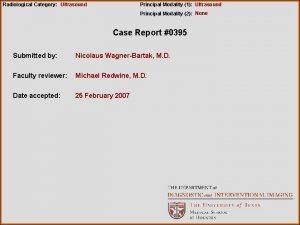Turan Saul M D Critical Ultrasound Review St







































































- Slides: 71

Turan Saul, M. D. Critical Ultrasound Review St. Luke’s Roosevelt Hospital Center

$100 $100 $200 $200 $300 $300 $400 $400 $500 $500 $600 $600

Trachea and Lungs

Cardiac

E-FAST and Pelvic

IVC and Soft Tissue

Lumbar Puncture And Peripheral IV

E-FAST and Pelvic IVC and Soft Tissue Lumbar Puncture And Peripheral IV $100 $100 $200 $200 $300 $300 $400 $400 $500 $500 $600 $600 Trachea and Lungs Cardiac

Thank You John Cahill, M. D. Resa E. Lewiss, M. D. William Bagley, M. D. Paul Travnicek, M. D.

The above image demonstrates? A. B. C. D. E. Vertebral shadowing Esophagus Linear foreign body Tracheal rings None of the above

D – Tracheal Rings • Tracheal rings • Cricothyroid membrane • High frequency linear probe • Sagittal plane Characteristic sonographic appearance of normal anatomy SLRUS

Indirect methods to assess the airway after successful intubation include? A. B. C. D. E. Bilateral, symmetric pleural sliding Visible comet-tail artifacts Symmetric diaphragmatic movement Midline tracheal rings A, B, and C

E - A, B, and C A. B. C. Bilateral, symmetric pleural sliding Visible comet-tail artifacts Symmetric diaphragmatic movement • These findings are normal, and do not raise concern for: - pneumothorax - right mainstem intubation - loss of oxygenation • Confirmation of midline tracheal rings with posterior shadowing is a direct method of assessment SLRUS

DAILY DOUBLE

The following image is concerning for an esophageal intubation because? A. B. C. D. E. The trachea is visible The esophagus is visible Impossible to tell from this image This is a normal image Need to evaluate in both transverse and sagittal planes.

B – The esophagus is visible • Esophagus is normally collapsed and not visible adjacent to the trachea • Posterior shadowing - trachea from cartilaginous rings - left para-tracheal area: esophagus opened by the endotracheal tube SLRUS

The “lung point” is? A. The name given to the transition point between expanded and collapsed lung B. The most sensitive sign of pneumothorax C. Present in normal, expanded lungs D. The superior most portion of the chest wall

A. The name given to the transition point between expanded and collapsed lung • Lung point - also known as the “leading edge sign” - 66% sensitivity for pneumothorax - not present in large pneumothorax, where retracted lung does not touch the wall - most specific sign of pneumothorax - data thus far shows never found in patients without pneumothorax SLRUS

What is the name of this sign? What pathology is associated with this sign? A. B. C. D. Adult respiratory distress syndrome Interstitial pneumonia Pulmonary edema Thickening of alveolar septa due to interstitial pulmonary disease

D. Thickening of alveolar septa due to interstitial pulmonary disease • “Multiple comet tail artifacts” - more than 3 in one rib space - less than 7 millimeters apart - arise from pleural line Indicative of any acute interstitial syndrome • DDx: adult respiratory distress syndrome, cardiogenic pulmonary edema, bacterial or other pneumonia, exacerbation of chronic interstitial diseases SLRUS

This image (sinusoid sign) was obtained with the ultrasound set on? A. B – mode B. M – mode C. Doppler mode And it is indicative of? A. Pneumothorax B. Pleural effusion C. Pneumonia D. Interstitial disease

B - M mode, B - Pleural effusion • “Sinusoid sign” - sign of respiratory interpleural variation - occurs as visceral pleural moves toward parietal pleural during inspiration when there is pleural effusion SLRUS

Mimics of pericardial effusion include? A. Pericardial fat pad B. Pleural effusion C. Intra-peritoneal fluid D. All of the above E. None of the above

D - All of the above These are all mimics of pericardial effusions - Pericardial fat pad - Pleural effusions - Intra-abdominal fluid SLRUS

A patient presents with muffled heart tones, hypotension, and JVD. Sonographic findings expected with this clinical presentation include? A. Diastolic collapse B. Dilated IVC without inspiratory variation C. Circumferential pericardial effusion D. A “swinging heart” E. All of the above

E – All of the above • The patient presents with the classic triad of cardiac tamponade • Tamponade includes all of these sonographic features • As little as 150 m. L of pericardial fluid can cause compression on the heart • “Scalloping” is diastolic collapse of the RV (or RA), while a “swinging heart” is counter-clockwise rotational movement of the heart SLRUS

The most accurate method of confirming asystole is? A. Lack of movement of valves B. M-mode C. Visualization of blood stasis D. Color Doppler E. Absence of ventricular contractions

B – M-Mode • Sonographic asystole is defined as absence of ventricular contraction • It is difficult to confirm lack of movement of valves or ventricular contraction simply by visualization • M-Mode can objectively assess whethere is movement at the level of the valves or ventricular contractions • This is a tool that may be used to direct cessation of resuscitative efforts SLRUS

Estimating left ventricular ejection fraction? A. Makes assumptions about the shape of the left ventricle B. Has good inter-rater reliability C. Is most accurate in symmetric ventricles D. Can be qualitative or quantitative E. All of the above

E - All of the above Measuring LV ejection fraction: - Makes assumptions about the shape of the left ventricle - Has good inter-rater reliability - Is most accurate in symmetric ventricles - Can be qualitative or quantitative SLRUS

A dilated right ventricle is seen on emergency ultrasound of a hypotensive patient. What may this finding indicate? A. Portal vein thrombosis B. Pulmonary embolus C. Hypovolemia D. Septic shock

B – Pulmonary embolus • A dialated right ventricle is a marker of elevated pulmonary pressures - pulmonary embolus - pulmonary hyptertension SLRUS

All of the following may cause difficulties in cardiac imaging except? A. Obesity B. Hyperinflated lungs in COPD C. Severe kyphosis D. Wide inter-costal spaces E. Pectus excavatum

D – Wide intercostal spaces • Heart encased in bony thorax, surrounded by lungs • Finding an acoustic window can be difficult • Stay close to left sternal border • Move patient into left lateral decubitus SLRUS

True or false? When evaluating the lungs as part of the E – FAST, you need to use a high frequency linear probe to rule out a pneumothorax FALSE

False • A low frequency curvilinear probe may be used • M-mode or color flow can be used for better visualization SLRUS

The most sensitive site for the detection of hemoperitoneum on your E-FAST is? The most dependent site of the peritoneal cavity is? Morison’s pouch, pelvis

Morison’s pouch, Pelvis • Inreased sensitivity of Morison’s pouch view for fluid - slight trendelenburg, 5º - inferior pole of right kidney, this is first site traumatic fluid is visible SLRUS

A hypotensive patient with a stab wound to the chest wall has this finding on your E-FAST. Your next step is? A. Prepare for a pericardiocentesis B. Prepare for an open thoracotomy C. Look for another cause of his hypotension D. Place bilateral chest tubes

C. Look for another cause of hypotension • Epicardial fat pad - can be confused with pericardial effusion • Effusions collect in the most dependant portion of the pericardial sac, i. e. posteriorly • Epicardial fat is seen anterior to the heart SLRUS

A B Identify the following structures: A. B. C. D. E. A) Vagina A) Bladder A) Uterus B) Bladder, Transverse plane B) Uterus, Transverse plane B) Bladder, Transverse plane B) Free fluid, Sagittal plane B) Bladder, Sagittal plane

E - A) Uterus B) Bladder Sagittal plane • Trans-abdominal - sagittal plane - body of the uterus posterior and cephalad to the bladder A B • This image demonstrates vaginal strip and cervix - in trans-vaginal images, bladder on the right side of the screen and less of the organ system visible SLRUS

Which is the correct progression of pregnancy as visualized by pelvic sonography? A. Intradecidual sign, yolk sac, gestational sac, embryo with cardiac activity B. Intradecidual sign, gestational sac, yolk sac, embryo with cardiac activity C. Gestational sac, embryo with cardiac activity, yolk sac, intradecidual sign D. Gestational sac, intradecidual sign, embryo with cardiac activity, yolk sac E. Yolk sac, embryo with cardiac activity, gestational sac, intradecidual sign

B - Intradecidual sign, gestational sac, yolk sac, embryo with cardiac activity • This marks the normal progression of changes in the body of the uterus with implantation of an IUP • The Emergency Physician may only confirm an IUP once the yolk-sac is visualized SLRUS

DAILY DOUBLE

A patient presents with a positive urine pregnancy test and vaginal bleeding in the 1 st trimester. She is hemodynamically stable and a bedside emergency pelvic ultrasound is indeterminate. The next best step is? A. Repeat bedside ultrasound in 30 min B. Obtain formal ultrasound and OB/Gyn consult C. Wait for results of the ß-HCG to decide D. Discharge the patient home with instructions E. Culdocentesis

B - Obtain formal ultrasound and OB/Gyn consult • The focused Yes/No question for pelvic ultrasound in 1 st trimester pregnancy is: Is there an intra-uterine pregnancy? • If the examination is indeterminate - proceed with specialist consultation and formal ultrasound • Ectopic pregnancy is the most life threatening concern SLRUS

D A B C Which letter corresponds to the IVC? A. A B. B C. C D. D

A - IVC • A. IVC: thin walled, respiratory variation, compressible, to the right of aorta, low flow • B. Aorta: thick echogenic walls, pulsatile, to the left of the IVC, non compressible, no respiratory variation, high flow • C: Vertebral body: Bone - very echogenic, posterior shadowing, posterior to vessels • D: Liver: medium echogenicity, heterogeneous, dense D A B SLRUS C

An 88 year old woman presents from home with 4 days of fever, lethargy, decreased PO intake and urinary incontinence. On arrival her vitals are: HR 128 BP 88/56 RR 20. She has dry mucus membranes and poor skin turgor. You expect on sonographic exam of her IVC? A. IVC plethora B. Greater then 50% collapse on inspiration C. Less then 50% collapse on inspiration D. Change only with sniff test

B – Greater than 50% collapse This scenario describes a pt with urosepsis and extreme fluid depletion • • In these cases, expect to see greater then 50% collapse (even complete collapse) of the IVC with inspiration IVC plethora is seen in fluid overload states < 50 % collapse during inspiration is normal The “sniff test” is done when there is no respiratory variation to ensure compliant patent vessels SLRUS

Which of the following is NOT a good way of measuring volume status using ultrasound of the IVC? A. B. C. D. Long axis sub-xyphoid Cross-section sub-xyphoid Right anterior axillary line: through the liver Pelvic: through the bladder

D - Pelvic: through the bladder • The IVC should not be measured in the pelvis • Long axis sub-xyphoid, cross-section subxyphoid, and right anterior axillary line have been described in the literature • Measure 3. 5 cm distal to the right atrium SLRUS

22 year old male history of IVDA presents with a hot red swollen painful arm for 3 days. You choose to ultrasound the area. Which of the following can not be evaluated using ultrasound? A. Abscess formation B. Location of vessels C. Cellulitis D. Foreign Body E. Necrotizing Fasciitis

E – Necrotizing Fasciitis Necrotizing fasciitis can not be diagnosed with ultrasound The others can be easily identified using ultrasound SLRUS

What image represents an abscess?

B - Abscess A. Cyst - thin walled, homogenous, fluid filled B. Abscess - thick walled, heterogenous, irregular boarders May demonstrate - septations, hyperechogenicity posterior shadowing C. Artery - thick walled, pulsatile, non-compressible D. Lymph node – homogenous, non-compressible SLRUS

22 year old male with history of IVDA presents with a hot red swollen painful arm for 3 days. You choose to ultrasound the area. You want to image in 2 planes, and identify surrounding structures. Which probe should you use? A. 3 -5 MHz curvilinear B. 3 -5 MHz phased array C. 5 -10 MHz linear array D. 8 -13 MHz intra-cavitary probe

• The 8 -13 intra-cavitary probe has good surface resolution, but the shape is awkward and the curved array makes it more difficult to use for procedural guidance • The 5 -10 MHz linear array has the best resolution for superficial structures with a shape convenient for procedural guidance SLRED

Which of the following best describes letter a? A. Ligamentum flavum B. Dura mater C. Spinous processes D. Sub-arachnoid space E. Transverse processes

C - Spinous processes a. Spinous process b. Dura mater/ligamentum flavum c. Sub-arachnoid space SLRUS

Ultrasound can assist in lumbar puncture by providing information about? A. The site of needle introduction B. The angle needed to approach the subarachnoid space C. The distance needed to obtain CSF D. All of the above

D – All of the above A. The site of needle introduction B. The angle needed to approach the subarachnoid space C. The distance needed to obtain CSF SLRUS

Which of the following is not true regarding ultrasound guided lumbar puncture? A. A paramedian approach allows for dynamic guidance B. It is of little use in a patient with multiple failed attempts C. Is most helpful in patients whose surface landmarks cannot be palpated D. Should be done using sterile technique

B - It will not be beneficial in a patient with multiple failed attempts • Ultrasound guidance can be helpful in patients with: – Obesity – Scoliosis / Arthritis – Anxiety – Failed Attempts SLRUS

Ultrasound guidance for vascular access? A. Decreased complication rates B. Decreases time to venipuncture C. Results in fewer needle stick attempts D. Enhances patient comfort E. All of the above

E – All of the above • Ultrasound-guidance has been shown in adult and pediatric populations to decreased complication rate, decreased procedure time, and reduce needle stick attempts. • Overall, patient comfort is more than without ultrasound-guidance SLRUS

While performing an ultrasound guided central line, the most accurate method of distinguishing artery from vein is? A. Compression technique: a vein will collapse while an artery will not B. Compression technique: an artery will collapse while a vein will not C. Visualization of the vessel in long-axis D. Visualization of the vessel in short-axis E. None of the above

• Short and long-axis are different ways that we can see the vessel, in cross-section or longitudinally respectively • In addition, one can visualize arterial pulsations and confirm artery vs. vein with Color Doppler SLRUS

Which is the preferred method of performing ultrasound-guided peripheral IV placement? A. Static ultrasonography with short-axis vessel visualization B. Static ultrasonography with long-axis vessel visualization C. Dynamic ultrasonography with short-axis vessel visualization D. Dynamic ultrasonography with long-axis vessel visualization

C - Dynamic ultrasonography with short-axis vessel visualization • Real-time ultrasound guidance (dynamic) is preferred over static ultrasonography since vessels often roll with placement of the line • Real-time guidance allows for more accurate placement and allows for needle redirection • Short-axis vessel visualization is easier and more accurate than long-axis • Under dynamic US, vessel tenting is seen prior to the catheter entering the vessel and ring-down artifact from the needle itself SLRUS
 Pcos ultrasound vs normal ultrasound
Pcos ultrasound vs normal ultrasound Critical semi critical and non critical instruments
Critical semi critical and non critical instruments Principle of sterilization
Principle of sterilization Ege ube
Ege ube Kevser turan
Kevser turan Geometrik ortalana
Geometrik ortalana Zakir turan
Zakir turan Kayhan turan
Kayhan turan Kayhan turan
Kayhan turan Zakir turan
Zakir turan Kayhan turan
Kayhan turan Cem turan bilgisayar mühendisi
Cem turan bilgisayar mühendisi Kayhan turan
Kayhan turan Değer kaybı hesaplama
Değer kaybı hesaplama Pitch faktörü
Pitch faktörü Kayhan turan
Kayhan turan Kayhan turan
Kayhan turan Kayhan turan
Kayhan turan Turan karahaner
Turan karahaner Turan
Turan Turan set
Turan set Nefret piramidi
Nefret piramidi Osman kaya turan
Osman kaya turan Pop q sınıflaması
Pop q sınıflaması Critical reading meaning
Critical reading meaning Ucl critical review
Ucl critical review Critical design review
Critical design review Critical design review template
Critical design review template Critical design review
Critical design review Drogue
Drogue Creswell literature map
Creswell literature map Book report meaning
Book report meaning Statistik inferensial menurut para ahli
Statistik inferensial menurut para ahli Critical design review
Critical design review Cdr critical design review
Cdr critical design review Saul david bibel
Saul david bibel Saúl desobedece a dios estudio bíblico
Saúl desobedece a dios estudio bíblico Saul became paul story
Saul became paul story Saul's disobedience
Saul's disobedience Charsimatic
Charsimatic Saul pursuing david
Saul pursuing david Saul was a native of
Saul was a native of Saul disobeys god
Saul disobeys god Pacman
Pacman Cave where david hid from saul
Cave where david hid from saul Indian horse book characters
Indian horse book characters Saul kripke
Saul kripke Saul envy david
Saul envy david Saul bass
Saul bass 1 samuel 18:8
1 samuel 18:8 Saul's conversion
Saul's conversion Saul leiter parents
Saul leiter parents Kitarist saul hudson
Kitarist saul hudson Caracteristicas de saul
Caracteristicas de saul Saul anointed king
Saul anointed king Saul david solomon
Saul david solomon God rejects saul
God rejects saul Estudio 48
Estudio 48 Turandot saul
Turandot saul Saul throws a spear at david
Saul throws a spear at david Long hours
Long hours Wilderness of ziph
Wilderness of ziph Indian horse plot diagram
Indian horse plot diagram Through plane
Through plane Caravaggio paul damascus
Caravaggio paul damascus Estructura organizacional de juan valdez
Estructura organizacional de juan valdez Easy raps for kids
Easy raps for kids Saul desobedece a dios estudio biblico
Saul desobedece a dios estudio biblico Paul becomes saul
Paul becomes saul Lessons from saul's conversion
Lessons from saul's conversion Ultrasound time gain compensation
Ultrasound time gain compensation Rejection ultrasound physics
Rejection ultrasound physics









